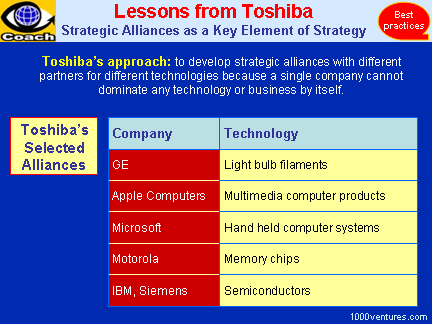| |
Toshiba firmly believes that a
single company cannot dominate
any technology or business by
itself. Toshiba’s approach is to
develop synergistic
relationships with different
partners for different
technologies. Strategic
alliances form a key element of
Toshiba’s corporate strategy.
|
|
 |
|
|
|
In early 1990s Toshiba
signed a coproduction
agreement for light bulb
filaments with GE.
Jack Welch, the
legendary former CEO of GE,
was a Toshiba’s admirer.
According to him, a phone
call to
Japan was enough to sort
out problems if and when
they arise, in no time.
Since then, Toshiba formed
various partnerships,
technology licensing
agreements and joint
ventures. Toshiba’s alliance
partners include Apple
Computers, Ericsson, GE,
IBM, Microsoft, Motorola,
National Semi Conductor,
Samsung, Siemens, Sun
Microsystems and Thomson.
Toshiba formed an alliance
with Apple Computer to
develop multimedia computer
products. Apple’s strengths
lay in
design and IT, while
Toshiba contributed its
manufacturing expertise.
|
|
|
|
|
In semiconductors, Toshiba,
IBM and Siemens came
together to pool different
types of skills. Toshiba was
strong in etching, IBM in
lithography and Siemens in
engineering. The
understanding among the
partners was limited to
research. For commercial
production and marketing the
partners decided to be on
their own.
In flash memory, Toshiba
formed alliances with IBM
and National Semi Conductor.
Toshiba’s alliance with
Motorola has helped it
become a world leader in the
production of memory chips.
The tie-up with IBM has
enabled Toshiba to become a
world’s largest supplier of
color flat panel displays
for notebooks.
Toshiba believes in a
flexible approach because
some tension is natural in
business partnerships,
some of which may also sour
over time. Toshiba
executives believe that the
relationship between the
company and its partner
should be like friends, not
like that of a married
couple.
|
|
|
|